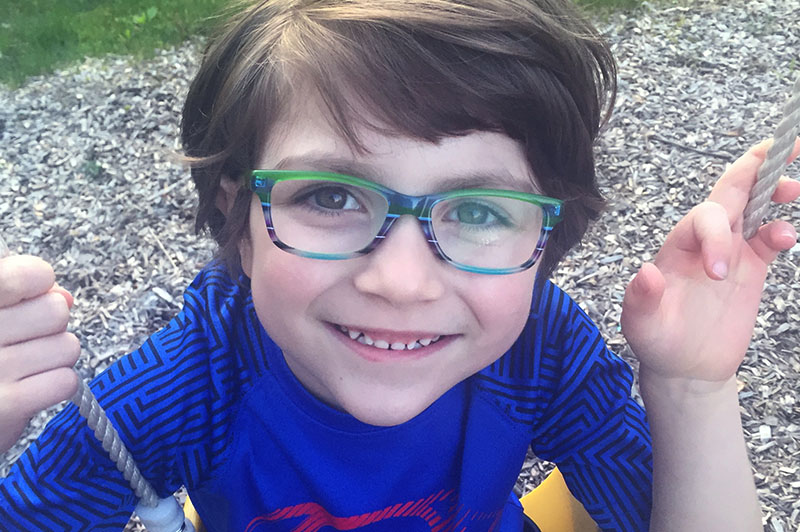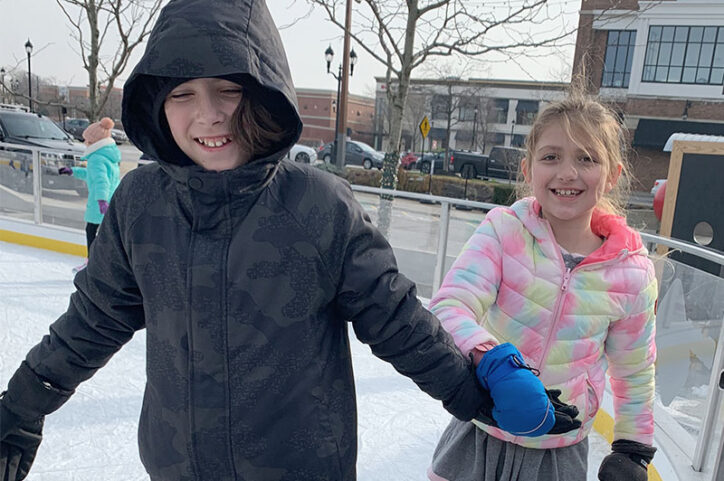After vascular ring surgery, playing and eating are a breeze for Louis

You can’t blame 10-year-old Louis McFaye for eating three hot dogs really fast.
Until last summer, he struggled to eat even a single hot dog cut into tiny pieces. That’s because he had a vascular ring, an abnormal formation of the aorta — the body’s largest blood vessel — that compressed his esophagus and trachea. Throughout his earlier life, he had difficulty swallowing and breathing. Enjoying his favorite foods and going for bike rides weren’t as simple or as fun as they should have been.
After Louis was diagnosed, his mother, Adrienne, had no doubt he would have surgery. It was just a matter of where he would have the operation. She sought a hospital that not only knew how to treat the complex condition but would also guide him through any psychological hurdles.
“It’s not just a clinical thing,” she says. “There’s also the whole emotional aspect of having surgery. That’s why I looked for a hospital that would get him physically better and help him manage the emotional factor.”
A struggle to eat and play
Louis initially seemed like a healthy baby; the first sign of his condition was how he wouldn’t settle in his crib. Until he turned 1 and started growing, he would sleep only if Adrienne sat in a chair and held him close. She, in turn, got little rest.
But his growth revealed more symptoms. He didn’t eat much, and when he did, it was only food that could be cut into digestible bites. Ramen noodles were a go-to staple. He also got winded anytime he ran. Adrienne realized she had to seek help when Louis struggled to keep pace with his sister, Livia, who is two years younger. For example, when the family went bicycling, Livia could ride for long stretches while Louis had to stop several times to catch his breath.

Testing at a hospital near their Cleveland home revealed Louis had a double aortic arch, a common type of vascular ring in which extra blood vessels create a second aortic arch that can constrict the trachea (or windpipe) and esophagus (food pipe). After researching the surgical programs of a few hospitals, Adrienne selected Boston Children’s.
She had two reasons. She was confident in the experience Christopher Baird, MD, lead cardiac surgeon of the Vascular Ring and Airway Compression Program, and Dr. Benjamin Zendejas-Mummert, surgical director of the Esophageal and Airway Treatment Center, had in treating double aortic arch. And, after visiting Boston Children’s for pre-surgery appointments, she felt assured the team would help Louis handle the emotional side of the operation. “I just fell in love with the staff and everybody,” she says. “It was family oriented and the right choice for us.”
Louis is now a whirlwind of activity
Surgery in July went “perfectly, even right down to the incision,” Adrienne says. “You can barely see it.” Just as importantly, Lauren Mednick, a Department of Surgery clinical psychologist who focuses on preparing kids for operations, truthfully addressed Louis’ concerns about what surgery entailed. “This was key for Louis: not downplaying the procedure but setting realistic expectations and being honest and authentic.”
Back home, Louis is trying to balance the excitement of being able to breathe normally with the time needed to build his physical stamina. He had been sedentary most of his life, Adrienne says, but now he can’t wait to play football and basketball. “Before he got the surgery, he kept saying, ‘I’m going to be like a normal child.’ I’d tell him he already was a normal child, but he had to limit the things he did. Now, he’s high energy and ready to go.”

He’s also ready to eat. After years of feeling full after slowly swallowing not even an entire hot dog, Louis now eats as many as three in one sitting. “Probably a bit too fast,” Adrienne adds. He still likes other old favorites, including spaghetti with Parmesan cheese, but on occasion he now asks for a steak. In between eating and ramping up physical activity, he quickly constructs Lego sets. He recently took those building skills to the videogame Minecraft.
“There was no way I was going to just settle and have the surgery anywhere and hope for the best,” Adrienne says. “I felt 100 percent confident going to Boston Children’s. It was worth it to have surgeons who could help him heal quickly and not be in the hospital for days, away from family, school, and friends. You couldn’t ask for anything better.”
Learn more about the Vascular Ring and Airway Compression Program or schedule a second opinion.
Related Posts :
-

'They just cared about Levi': Finding answers for a complex vascular ring
The first sign that Levi Blair Winkler would no longer have problems swallowing was when, only three days after a ...
-

Treating vascular rings: Sisters travel more than 3,000 miles for care
Nicky Dickerhoff is no stranger to caring for children: Not only is she a neonatal nurse practitioner, but she and ...
-

Five things parents should know about vascular rings
If your child has a high-pitched cough, breathes loudly, wheezes, has difficulty eating or swallowing, or always seems to be ...
-

Vascular rings: A complex cause of noisy breathing
Patients who present with noisy breathing, wheezing, a barking cough, and frequent respiratory infections are often misdiagnosed with asthma or ...





